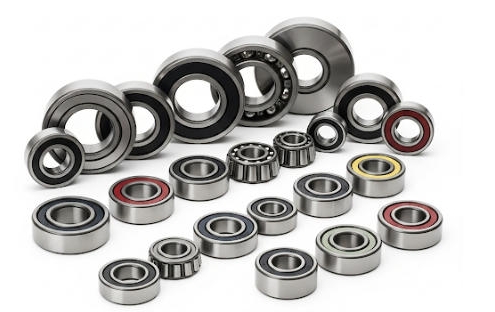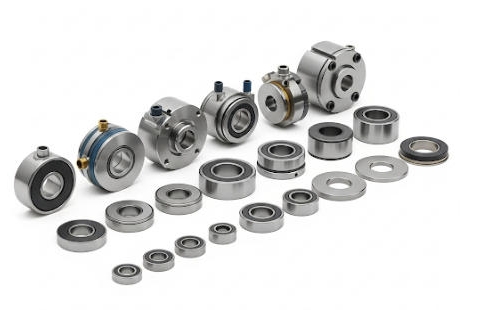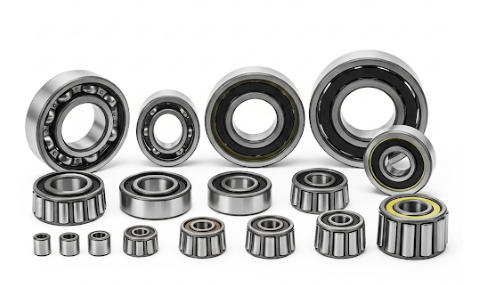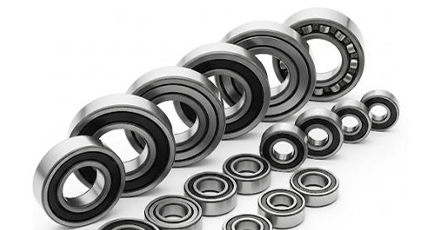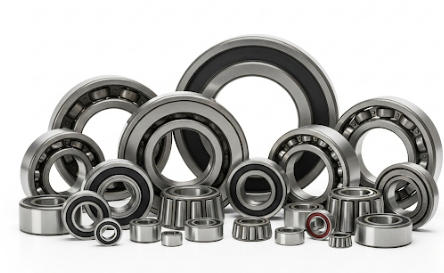Choosing the wrong bearing types often leads to mechanical failures, increased downtime, and higher costs. Engineers struggle with the balance between performance and cost while procurement managers face the challenge of sourcing reliable bearings mechanical. The right decision ensures durability, efficiency, and precision across industries.
Bearings types include ball, roller, plain, fluid, and magnetic bearings. Each type of bearing has its own working principle, bearing components, performance benefits, and industrial uses. By understanding different types of bearings and matching them with proper CNC Machining, engineers and buyers can achieve higher reliability and lower maintenance costs.
Now, let’s explore the different bearing types through various classification dimensions and applications.
What is Bearing?
The bearing definition engineering refers to a machine element that allows constrained relative motion between two or more parts, typically rotation or linear movement. The mechanical bearing definition emphasizes the reduction of friction, the support of loads, and the precise guidance of moving components.
In CNC Machining, bearing kinds are indispensable. Spindles, tool changers, and linear guides all depend on different kinds of bearings to ensure precision.
Type of Bearings
The selection of different types of bearings depends on their structure, load direction, friction characteristics, and application fields. Each bearing type is designed for specific operating conditions and engineering requirements. Understanding these helps engineers, procurement managers, and manufacturers identify the best solution for their equipment and processes.
1. Classification by Structure
Structural differences create various types of bearings suited for specific conditions. Each type has unique features, advantages, and limitations that determine its typical applications.
Ball Bearing
Ball bearings are the most common and versatile type of bearing. A simple ball bearing consists of an inner ring, outer ring, balls, and a cage that maintains the spacing of the balls. Because the rolling elements make point contact with the raceways, ball bearings can operate at high speeds with relatively low friction and noise. However, their load capacity is limited compared to roller bearings. Typical uses include medical devices, optical instruments, household appliances, and electric motors.
Roller Bearings
Roller bearings differ from ball bearings in that the rolling elements are cylinders instead of spheres, creating line contact with the raceways. This gives them a significantly higher load-carrying capacity and greater resistance to shock and vibration. Common types include cylindrical roller bearings, tapered roller bearings , spherical roller bearings, and needle roller bearings. Their speed capability is generally lower than ball bearings, but they are highly durable and suited for automotive gearboxes, railways, heavy machinery, and industrial equipment.
Plain Bearings
Also known as sleeve bearings or journal bearings, plain bearings operate without rolling elements. Instead, they rely on sliding contact between the shaft and the bearing surface, often with a lubricant film in between. Their simple structure, high load capacity, and excellent ability to withstand impact and vibration make them suitable for heavy-duty applications. While they cannot reach high speeds like ball or fluid bearings, they excel in low-speed, heavy-load conditions. They are commonly found in turbines, large pumps, agricultural machinery, and marine engines where reliability and robustness are critical.
Fluid Bearings
Fluid bearings use a thin film of liquid or gas to completely separate the bearing surfaces. This eliminates direct contact, resulting in almost zero wear, extremely low friction, and long service life. Fluid bearings are widely applied in CNC machine spindles, high-speed compressors, turbines, and computer hard disk drives (HDDs).
Magnetic bearings
Magnetic bearings employ magnetic levitation technology to suspend the shaft without any physical contact. This allows ultra-high-speed rotation, complete elimination of wear, and operation in environments where lubricants are impractical. Active magnetic bearings are controlled by electromagnets and sensors, providing adaptive stability and advanced monitoring, while passive designs may use permanent magnets. They are expensive and require sophisticated control systems but offer unmatched performance in specialized fields such as aerospace turbines, advanced medical technology, high-speed energy storage flywheels.
2. Classification by Load Direction
Load direction significantly impacts bearing types and uses. Bearings are designed to handle forces in specific directions to optimize performance and durability.
Radial Bearings
Radial bearings are designed to support loads perpendicular to the shaft axis, transferring the force through rolling elements or sliding surfaces. They are widely used in applications where the primary stress is radial, such as wheel hubs, pulleys, electric motors, and conveyor rollers. Their structure allows smooth rotation under moderate to high radial loads.
Thrust Bearings
Thrust bearings handle axial loads, meaning forces parallel to the shaft axis. These bearings prevent axial movement and provide stability in rotational systems. They are widely used in applications like automotive transmissions, rotating tables, and propeller shafts, where axial forces are significant.
Angular Contact Bearings
Angular contact bearings are designed to support both radial and axial loads simultaneously, with an offset contact angle between the rolling elements and raceways. They are widely used for high-precision systems such as CNC spindles, machine tools, and high-speed pumps.
Combined Load Bearings
Combined load bearings are engineered for complex load scenarios where both significant radial and axial forces are present. They integrate design features from radial and thrust bearings, providing stability and high load capacity. Common uses include gearboxes, heavy industrial machinery, and precision rotating equipment.
3. Classification by Application Field
Different industries require specific bearing types to meet operational and durability needs. Selecting the right bearing ensures reliability, efficiency, and long service life under specific operational conditions.
Automotive industry
In the automotive sector, roller bearings and ball bearings dominate due to their ability to handle both radial and axial loads. They ensure durability and reliability in transmissions, wheel hubs, differential gears, and steering systems. Bearings in this industry must withstand vibration, shock loads, temperature fluctuations, and high-speed rotation while maintaining smooth operation. Advanced applications also use tapered roller bearings for axle and gearbox assemblies and needle bearings in compact, high-load locations.
Medical industry
Medical applications rely heavily on ball bearings because of their precision, low friction, compact size, and quiet operation. These features are critical in MRI scanners, surgical robots, dental drills, and laboratory instruments, where stability, hygiene, and reliability are essential. Some applications may also use miniature or ceramic ball bearings to resist corrosion, reduce weight, and operate in sterilizable environments, ensuring long-term performance with minimal maintenance.
Industrial machinery
Industrial machinery often uses bearing blocks, roller bearings, and plain bearings to handle heavy-duty cycles, high loads, and continuous operation. Bearings in this field must resist shock, contamination, and high temperatures while providing consistent performance over extended periods. Some industries may combine spherical roller bearings for self-aligning properties with plain bearings for high-load shafts.
Aerospace
Aerospace applications employ magnetic and fluid bearings for high-speed turbines, gyroscopes, and satellite equipment, where ultra-low friction, reliability, and minimal maintenance are critical under extreme conditions. Bearings in this field must withstand vibration, high temperatures, vacuum environments, and rapid acceleration while maintaining precise operation.
Electronics
In electronics, ball bearings provide smooth rotation for hard drives, cooling fans, optical devices, and precision instruments. They support high-speed, low-noise operation while minimizing wear and energy consumption. Some applications, such as micro-motors or miniature fans, require miniature or hybrid ceramic bearings to reduce size and enhance reliability in compact electronic assemblies.
Comprehensive Overview of Bearing Types and Their Advantages and Disadvantages
The following provides a comprehensive comparison of bearing types based on their structure, load direction, and application field. It highlights the key advantages and disadvantages of each type, helping engineers, designers, and procurement professionals make informed decisions when selecting bearings for specific operating conditions and industry requirements.
| Bearing Type / Application | Advantages | Disadvantages |
|---|---|---|
| Ball Bearings (Structure) | High-speed capability; low friction; compact design; low noise; easy installation | Limited load capacity; sensitive to shock and vibration; lifespan affected by load |
| Roller Bearings (Structure) | High load capacity; strong shock resistance; durable | Generally lower speed than ball bearings; larger size; complex structure; higher cost |
| Plain (Sliding) Bearings (Structure) | Very high load capacity; strong impact resistance; simple structure; low cost | Low speed; higher friction; requires lubrication; higher maintenance |
| Fluid Bearings (Structure) | Extremely low friction; almost zero wear; long service life; ideal for high-speed precision applications | Requires controlled lubricant or gas; high cost; complex; sensitive to environment |
| Magnetic Bearings (Structure) | Contact-free; long lifespan; ultra-low friction; suitable for ultra-high speed and vacuum | Very high cost; requires complex control system; high technical requirements |
| Radial Bearings (Load Direction) | Supports radial loads; simple structure; easy installation | Not suitable for high axial loads; may require axial constraints |
| Thrust Bearings (Load Direction) | Supports axial loads; prevents axial movement | Poor radial load capacity; structure may take more space |
| Angular Contact Bearings (Load Direction) | Supports both radial and axial loads; ideal for high-precision, high-speed applications | High installation precision required; higher cost; requires lubrication |
| Combined Load Bearings (Load Direction) | Handles complex load scenarios; high load capacity | Complex structure; high cost; design and maintenance requirements are high |
| Automotive Bearings (Application) | Handles both radial and axial loads; vibration-resistant; suitable for high and low speed; long lifespan | Higher cost; some types occupy more space; maintenance and lubrication required |
| Medical Bearings (Application) | High precision; low friction; low noise; compact; corrosion-resistant options | Limited load capacity; higher cost; sensitive to contamination |
| Industrial Machinery Bearings (Application) | High load capacity; impact-resistant; suitable for continuous operation | Higher friction (plain bearings); requires lubrication and maintenance; larger size |
| Aerospace Bearings (Application) | Ultra-high speed; contact-free or minimal wear; low friction; suitable for extreme conditions | Very high cost; complex design; requires advanced technical expertise |
| Electronics Bearings (Application) | High-speed, low-noise; precise; reliable; compact | Limited load capacity; higher cost; small particles or contamination can reduce lifespan |
In Conclusion
By understanding bearing definition engineering, different types of bearings and their applications, and matching them with precision CNC Machining, engineers and procurement managers can ensure optimal performance. In high-precision CNC Machining, the integration of correct bearing components ensures tolerance control to 0.001 mm. A reliable cnc machining manufacturer like VMT provides the precision and customization necessary to integrate the best bearings types into your machines.
Frequently Asked Questions About Bearings
What are the 4 Types of Bearings?
The four main types are ball bearings, roller bearings, plain bearings, and fluid bearings. Ball and roller bearings use rolling elements to reduce friction. Plain bearings rely on sliding contact. Fluid bearings use a thin film of liquid or gas to separate surfaces, enabling near-zero wear.
What is a Bearing Used For?
A bearing supports and guides rotating or moving parts, reducing friction between surfaces. Its main role is to carry radial or axial loads while ensuring smooth, efficient, and precise motion in machinery, vehicles, electronics, and industrial equipment.
What’s the Difference Between C3 and C4 Bearings?
C3 and C4 indicate internal clearance (the space between rolling elements and raceways). C3 bearings have more clearance than standard, and C4 has even more than C3. Greater clearance helps manage higher speeds, higher operating temperatures, and thermal expansion without causing premature wear.
Why are They Called 608 Bearings?
“608 bearing” follows a standard numbering system. The first digit (6) indicates it’s a single-row deep groove ball bearing. The next two digits (08) refer to the bearing’s size series and bore diameter: 08 means an 8 mm inner diameter. These bearings are widely used in skateboards, fans, and electric motors.

